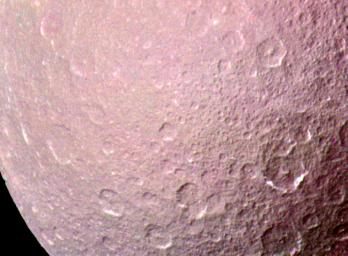
|
Saturn’s Moon Rhea
- Click the image above for a larger view
- Full-Res JPEG (870 x 640) (100.3 kB)
- Full-Res TIFF (870 x 640) (1.5 MB)
Caption:
NASA's Voyager 1 took this high resolution color image of Rhea just before the spacecraft's closest approach to the Saturnian moon on Nov. 12, 1980 from a range of 128,000 kilometers (79,500 miles). The area shown is one of the most heavily cratered on Rhea, and indicates an ancient surface dating back to the period immediately following the formation of the planets 4.5 billion years ago. The photograph shows surface features about 2.5 kilometers (1.5 miles) in diameter, similar to a view of Earth's Moon through a telescope. Other areas of Rhea's surface are deficient in the very large (100 kilometers or 62 miles or larger) craters, indicating a change in the nature of the impacting bodies and an early period of surface activity. White areas on the edges of several of the craters in the upper right corner are probably fresh ice exposed on steep slopes or possibly deposited by volatiles leaking from fractured regions.
Background Info:
The Voyager Project is managed for NASA by the Jet Propulsion Laboratory, Pasadena, California.
Cataloging Keywords:
| Name | Value | Additional Values |
|---|---|---|
| Target | Rhea | |
| System | Saturn | |
| Target Type | Satellite | |
| Mission | Voyager | |
| Instrument Host | Cassini Orbiter | Voyager 1 |
| Host Type | Orbiter | Flyby Spacecraft |
| Instrument | Imaging Science Subsystem (ISS) | |
| Detector | ||
| Extra Keywords | Color, Crater, Impact, Moon | |
| Acquisition Date | ||
| Release Date | 2000-02-07 | |
| Date in Caption | 1980-11-12 | |
| Image Credit | NASA/JPL | |
| Source | photojournal.jpl.nasa.gov/catalog/PIA02240 | |
| Identifier | PIA02240 | |
